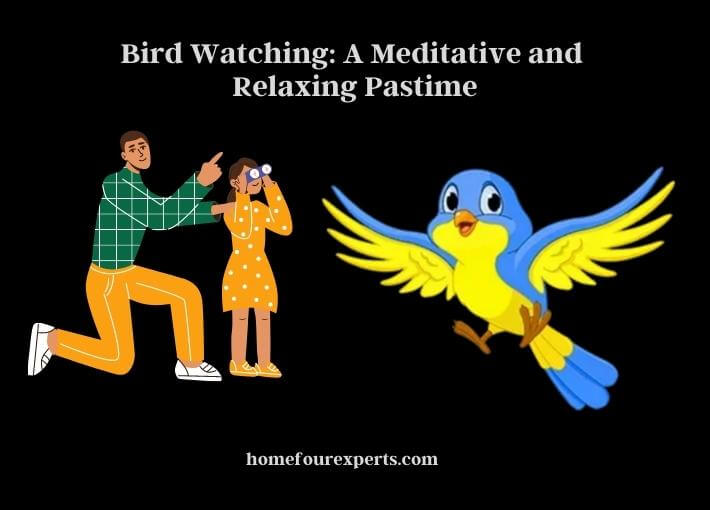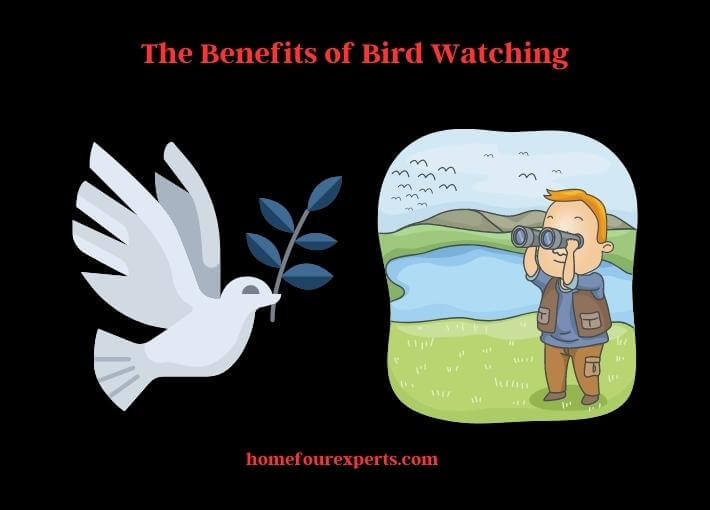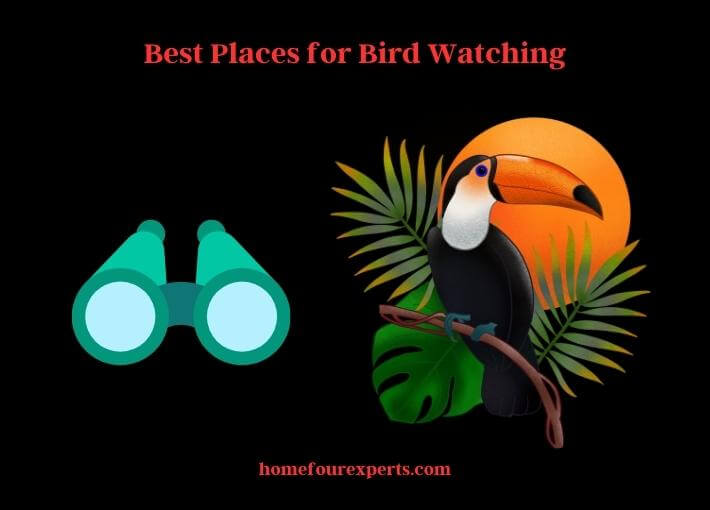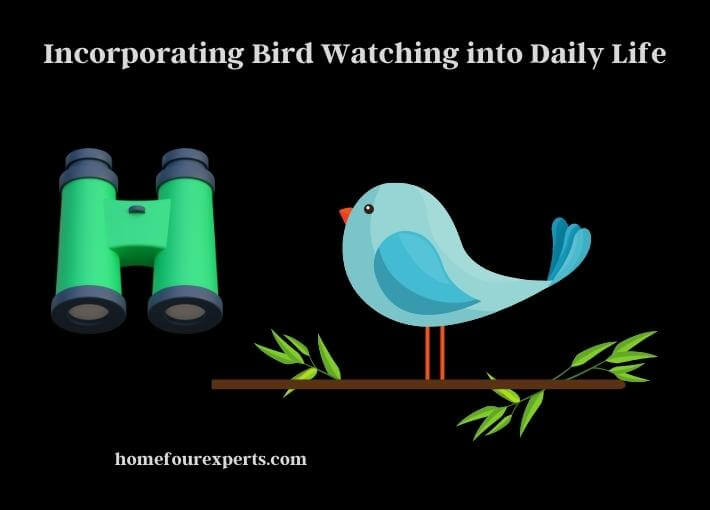In today’s fast-paced world, it can be challenging to find time to relax and unwind. Between work, family, and other obligations, it can feel like there’s always something that needs our attention. This is why finding a hobby that allows us to disconnect from our daily stresses and connect with nature can be so valuable. Bird watching is one such hobby that has gained popularity in recent years. It offers a chance to slow down, appreciate the beauty of the natural world, and learn about different bird species.

Bird watching can be enjoyed by people of all ages and fitness levels. Whether you live in a rural or urban area, there are likely to be bird species around you that you can observe. In fact, you might be surprised to learn how many different types of birds live in your local park or neighborhood. All you need is a good pair of binoculars, some basic knowledge of bird identification, and a willingness to be patient and observant.
Not only is bird watching a relaxing and enjoyable pastime, but it also provides numerous health benefits. Studies have shown that spending time in nature can reduce stress, improve mood, and enhance concentration and memory skills. Plus, it’s a low-impact form of exercise that allows you to get some fresh air and enjoy the outdoors.
If you’re looking for a new hobby that can help you disconnect from the stresses of daily life and connect with nature, then bird watching might be just what you need. In the rest of this article, we’ll explore the benefits of bird watching in more detail and provide tips on how to get started.
The Benefits of Bird Watching
1. Reduces Stress and Anxiety
Bird watching is a calming activity that can help reduce stress and anxiety. It requires you to be present at the moment and focus on the birds around you. This can help distract you from your worries and give your mind a break. Studies have shown that spending time in nature can reduce cortisol levels, which is a hormone associated with stress.
2. Improves Mental Health
Bird-watching is a great way to improve your mental health. It’s a low-impact activity that can be done at your own pace. It also gives you the opportunity to connect with nature and appreciate its beauty. Studies have shown that spending time in nature can help improve mood and reduce symptoms of depression.

3. Enhances Concentration and Memory
Bird-watching requires a certain level of concentration and attention to detail. It involves observing the birds and their behaviors, as well as identifying different species. This can help improve your concentration and memory skills.
4. Provides Exercise
Bird watching involves walking and hiking, which can provide a good source of exercise. It’s a low-impact activity that can be enjoyed by people of all ages and fitness levels.
5. Connects You with Nature
Bird watching is a great way to connect with nature and appreciate its beauty. It gives you the opportunity to observe birds in their natural habitats and learn more about their behaviors and habitats. This can help increase your appreciation for the natural world and inspire you to take steps to protect it.
Getting Started with Bird Watching
1. Invest in a Good Pair of Binoculars
One of the most important tools for bird watching is a good pair of binoculars. They allow you to observe birds from a distance without disturbing them. Look for binoculars that are lightweight and have a wide field of view.
2. Learn to Identify Birds
Learning to identify birds is a key part of bird watching. There are many field guides and smartphone apps available that can help you learn to identify different species. Start by learning the most common birds in your area and work your way up from there.
3. Find Good Birding Locations
Finding good birding locations is essential for a successful bird-watching experience. Look for parks, nature reserves, and other areas with diverse habitats. Consider joining a local birding club or group to get tips on the best locations in your area.
4. Practice Patience and Respect
Bird watching requires patience and respect for the birds and their habitats. Avoid disturbing the birds or their nests, and don’t try to get too close to them. Use a quiet voice and movements to avoid scaring them away.
5. Keep a Birding Journal
Keeping a birding journal is a great way to track your observations and progress. Record the date, time, location, and species of the birds you observe. You can also note any interesting behaviors or interactions you witness.
Best Places for Bird Watching
Bird watching can be done anywhere there are birds, but some locations offer better opportunities than others.

National Parks
National parks are home to a wide variety of bird species. Some of the best parks for bird watching include Acadia National Park in Maine, Everglades National Park in Florida, and Yosemite National Park in California.
Wildlife Refuges
Wildlife refuges are managed areas that provide habitat for wildlife, including birds. Some of the top wildlife refuges for bird watching include Bosque del Apache National Wildlife Refuge in New Mexico, J.N. “Ding” Darling National Wildlife Refuge in Florida, and Horicon Marsh State Wildlife Area in Wisconsin.
Beaches
Many species of birds are found along coastlines, making beaches an excellent place for bird watching. Some of the best beaches for bird watching include Cape May in New Jersey, Santa Cruz in California, and Padre Island in Texas.
Wetlands
Wetlands are vital habitats for birds, and many species can be found in these areas. Some of the top wetland areas for bird watching include the Great Salt Lake in Utah, the Okefenokee Swamp in Georgia, and the Everglades in Florida.
Bird Sanctuaries
Bird sanctuaries are areas set aside specifically for the protection of birds and their habitats. These areas are often some of the best places to see a wide variety of bird species. Some of the top bird sanctuaries for bird watching include the National Aviary in Pennsylvania, the Audubon Society’s Corkscrew Swamp Sanctuary in Florida, and the Cornell Lab of Ornithology’s Sapsucker Woods in New York.
No matter where you live or travel, there are likely to be excellent bird-watching opportunities nearby. Do some research on the best places to see birds in your area, and don’t be afraid to explore new locations to expand your bird-watching horizons.
Tips for Bird Watching
- Binoculars are an essential tool for bird watching. They allow you to get a close-up view of birds without disturbing them. Look for binoculars with good magnification and lens quality.
- Learning to identify birds is a key part of bird watching. Start with the most common birds in your area and work your way up to more challenging species. Use a field guide or birding app to help with identification.
- Look for places with good bird habitats, such as parks, nature reserves, and wetlands. Set up in a quiet spot where you can observe birds without disturbing them.
- Bird-watching requires patience and persistence. Birds can be elusive and may take time to appear. Sit quietly and wait for them to come to you.
- Many bird species are identified by their unique calls and songs. Learn to recognize different bird sounds to help with identification.
- Dress in layers and wear comfortable shoes for long walks. Avoid bright colors and flashy jewelry, which can scare off birds.
- Remember that you are a guest in the birds’ habitat. Avoid disturbing their nests or feeding them human food, which can be harmful to their health.
- Joining a birding group can be a great way to learn from experienced birders and share your passion for bird-watching with others.

Bird watching is a rewarding hobby that can be enjoyed by people of all ages and skill levels. With a little patience and practice, you’ll be able to identify a wide variety of bird species and appreciate the beauty of the natural world.
Social and Community Aspects of Bird Watching
Bird watching is not only a solitary activity; it can also be a social and community-driven hobby.
Birding Clubs and Groups
Joining a birding club or group can be a great way to connect with other birders in your area. These groups often organize bird-watching outings, workshops, and lectures.
Citizen Science Projects
Many bird-watching enthusiasts participate in citizen science projects, which involve collecting data on bird populations and behavior. This can be done individually or as part of a larger group effort.
Conservation Efforts
Bird-watching can also be a way to engage in conservation efforts. Many birders participate in bird banding, habitat restoration, and other conservation activities to protect bird species and their habitats.
Education and Outreach
Bird-watching can be used as a tool for education and outreach. Birders can share their knowledge and passion with others through workshops, presentations, and community events.
Travel and Tourism
Bird-watching can also be a popular form of travel and tourism. Many destinations around the world offer unique bird-watching opportunities, and some communities have built their tourism industry around bird-watching.
Incorporating Bird Watching into Daily Life
Bird-watching doesn’t have to be a weekend or vacation activity.

Setting up a bird feeder outside your home or office window can provide a daily dose of bird watching. You can observe birds while working or relaxing at home.
Take a walk around your neighborhood or local park and pay attention to the birds you see and hear. Try to identify different species and learn more about their behavior and habitats.
There are many birding apps available that can help you identify birds and track your sightings. Use them while on your daily commute or during your lunch break.
Joining a citizen science project can provide a structured way to incorporate bird watching into your daily life. Look for projects that allow you to collect data on bird populations in your area.
Many cities and towns host birding events throughout the year, such as bird walks and birding festivals. Attend these events to connect with other birders and learn more about bird watching in your area.
Incorporating bird watching into your daily life can provide a sense of connection to nature and can be a relaxing and fulfilling way to spend your time. With a little creativity and effort, you can enjoy the beauty of birds every day.
It’s true that you will not get all the variations of free weight exercises in compact gyms. But If we talk about the power station or smith machine we can get the same equipment in the compact gyms. See here for more information.
How Can Bird Watching Help with Choosing the Right Binoculars?
When it comes to bird watching, having the right binoculars for bird watching can make all the difference. The right pair can offer clear, sharp images and comfortable viewing. Look for features like high magnification, large objective lenses, and a wide field of view to enhance your bird watching experience.
The Bottom Line
Birdwatching is a meditative and relaxing pastime that offers many benefits to enthusiasts. It provides a way to connect with nature, find inner peace, and observe the beauty and complexity of birds. Whether enjoyed alone or with others, bird watching can be a fulfilling and enriching hobby with many social and community benefits.
By following the tips and suggestions outlined in this article, anyone can start bird watching and incorporate it into their daily life. Whether you are a beginner or an experienced birder, the world of bird watching is waiting to be explored. So grab a pair of binoculars, head outdoors, and enjoy the wonders of the avian world.
About This Writer

Guys, I am Camila Avery and I love to help my mom to do indoor & outdoor activities. As a lady, I have passed my time on gardening, home improvement, and personal or self-care. I have acquired some degrees in outdoor recreation, beauty, and hair care. It is not easy to work with top-level professional beauty experts. But, I got that opportunity and experimented with different hair extensions, hair colors, and cuts.